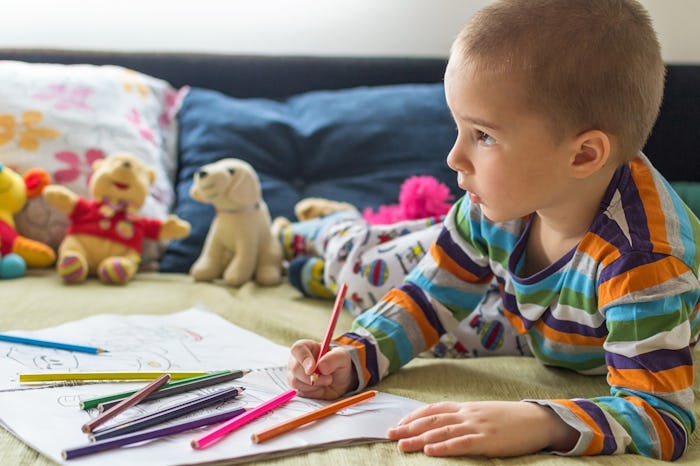Life
Kids' Doodles Reveal How Their Attitudes On Gender Stereotypes Are Changing, Study Finds
It seems innocuous enough; you ask a bunch of school kids to draw a scientist, and watch to see what they put down on paper. It's an experiment that has been going on for the past 50 years, and one that saw some pretty disheartening results for women. For the most part, students drew men in lab coats. Some with glasses, some without, some with notes and beakers and other research items. But they had one thing in common... they were almost all men. Happily, a new study on kids' drawing reveals how gender stereotypes might, in fact, finally be changing on an elementary level, and it's really amazing news for both boys and girls.
Researchers out of Northwestern University in Illinois decided to look at data compiled from a five decade long study called "Draw-A-Scientist," an experiment that asks children to simply draw scientists that was first implemented by social scientist David Chambers in 1966. During the initial study, Chambers and a group of researchers asked 4,807 elementary school students in the United States and Canada to draw their version of a scientist. This study went on from 1966 to 1977, and the results, as I mentioned, were less than encouraging for feminists. In the original study, which was published in 1983, only 28 out of nearly 5,000 pictures depicted a female scientist. And those were only drawn by little girls.
Well, it looks like we've come a long way since those dark days when fewer than 1 percent of elementary school children pictured a woman when they thought of scientists. David Miller of Northwestern University decided to analyze the data collected from 78 studies over the past 50 years to see if there had been any changes along the way. And the news, while not exactly overwhelming, is cause for mild celebration at the very least.
Miller and his team of researchers looked at the drawings of more than 20,000 elementary school kids and discovered that, since the 1980s, 28 percent of kids on average drew a female scientist. In other words, female scientists went from being almost invisible in the eyes of children (less than 1 percent) to being represented almost one-third of the time.
Gender stereotyping has been a particularly onerous problem in the scientific field for generations, where women have been vastly underrepresented since at least the 1970s. Hopefully, this is about to change. More women are earning degrees in science than ever before; 48 percent of women are employed in biological sciences, according to CNN, up from just 20 percent in 1960.
There's also the media representation of scientists that can make an enormous difference; as Miller noted, movies like Hidden Figures, which told the story of black female scientists at NASA, can help change the conversation for kids. Miller also told CNN that the children's science magazine Highlights has increasingly depicted women as scientists; women have been pictured in the publication 44 percent of the time in recent years, up from only 13 percent in the 1960s.
Children aren't born with gender stereotypes and are massively affected by what they see in the world around them. The more women scientists who are represented in pop culture, the easier it will be for young girls to picture themselves studying science as they grow, as Miller told CNN:
Parents and teachers should be aware that elementary and middle school is a critical period when children are starting to learn stereotypes about scientists. It important that students are exposed to diversified examples of scientists.
Unfortunately, the road ahead remains long. Boys were still only drawing female scientists just 5 percent of the time, and girls tended to draw men as scientists as they grew older. At the age of 6, girls were drawing female scientists around 70 percent of the time. By age 10 to 12, they were drawing male scientists around 75 percent of the time.
But here's the thing: progress takes time. And the more female scientists we see represented in pop culture, the more likely it might be for young girls to become scientists themselves. Because we all need role models, don't we?
Check out Romper's new video series, Bearing The Motherload, where disagreeing parents from different sides of an issue sit down with a mediator and talk about how to support (and not judge) each other’s parenting perspectives. New episodes air Mondays on Facebook.
